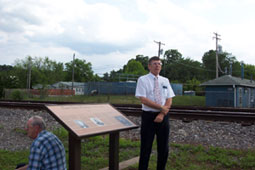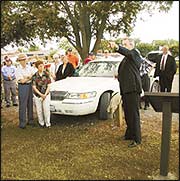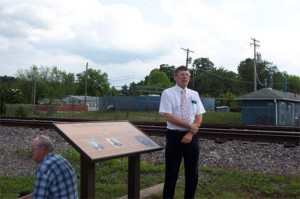Montrose, Iowa Monuments (2003)

Photo courtesy: Fred E. Woods.
The Foundation created this monument located at the old Fort Des Moines Fort in Montrose, Iowa. Montrose was an important area for the early Church. In fact, at one point in the Church’s history, the only two stakes of the Church were located in Nauvoo and in Montrose.
At the dedication, Doug Atterberg, a local historian, presented a part of the history of Fort Des Moines and the role it played in the early history of the Church.
Photos
Articles & Resources
Two-day history symposium relates county's ties to Mormon Church
Author(s): Steve Dunn
Published in: Daily City Gate
Publication Date:

One and hundred fifty years ago Mormons helped grade Keokuk’s streets.
This week they’ve paid for new curbs around the end of Triangle Park where a marker will be located to commemorate the 150th anniversary of the Mormon encampment in the park.
The Mormons’ ties to Keokuk and Montrose will take center stage during the Lee County History Symposium and sesquicentennial of the 1853 Mormon encampment in Keokuk tonight and Saturday. Most of the activities, including presentations by 10 persons, will take place on Saturday at the Holiday Inn Express.
Two of the speakers, Doug Atterberg of Keokuk and BYU professor Fred Woods, have written a 23-page paper on “The 1853 Mormon Migration Through Keokuk.”
Woods also is executive director of the Mormon Historic Sites Foundation, which paid for the new curbs near the new marker in Triangle Park.
Their paper cites an April 26, 1853, article in the Keokuk Dispatch which said, “A large number of Mormons are now employed in grading the streets of our city. Each man is a ‘full team’ behind a pick and shovel. A pile of dirt before a dozen or two of these hard fisted, strong fellows is ‘nowhere.’ The rough places of our city are rapidly becoming smooth and if the Mormons remain here awhile longer, our streets will present quite a different appearance from what they have presented heretofore. We are not sorry to see this improvement going on. Nothing needs improvement worse than the streets of our city.”
As for the improvements this week, Woods said, “I’m happy for Keokuk to have the new curbs in the park. We want to do good.”
By 1853 Keokuk’s population of 3,200 had nearly doubled with the migration of Mormons from Europe, Canada and the East Coast. More than 2,500 Mormons alone from Britain and Scandinavia had come to Keokuk by then, according to Woods who will speak Saturday morning on “Mormon Maritime Migration from England to Keokuk in 1853.”
In May 1853 William Belknap, who later served as a major general in the Civil War and as secretary of war to President Grant, wrote the following to his sister, Clara, about the Mormon emigrants who were outfitting in Keokuk that spring and summer: “Yesterday was Sunday and I wish you had been here to go up to the Mormon Camp with me. They had preaching at three stands in three languages – English, German and Danish. They sing – especially the Danes – very sincerely and are perfectly enthusiastic. It is a strange, strange mystery and if you were here you’d be astonished. There are nearly 3,500 here now and ‘still they come’ by every boat and some of them are genteel and many of the girls very pretty … The Mormons are mainly honest, earnest and sincere.”
Most of the Mormon emigrants apparently liked what they saw when they reached the encampment in Keokuk, according to Atterberg’s and Woods’ paper.
As one migrant noted, “Elder Isaac C. Haight, who was the Church Emigration agent at the outfitting point, selected a very healthy camping place at Keokuk, on a bluff near the river, where there was plenty of wood and grass handy. The citizens of Keokuk manifested a benevolent feeling toward the Saints, which was highly appreciated by them.”
Professional artist Frederick Piercy, who published a sketch of the encampment in 1855, said that after he climbed a steep bluff on the edge of the river, he “found most picturesquely situated on top of a hill, surrounded by wood, and commanding a view of the country for miles around. The situation was admirably chosen, as there were good drainage and an abundance of wood and water combined.”
Atterberg’s and Woods’ paper also notes that as some of the Mormons prepared for their journey to Salt Lake City, they took time to see the dilapidated Nauvoo Temple and visit Emma and Lucy Mack Smith, the widow and mother of Prophet Joseph Smith.
It appears the Mormons’ presence left a moral and physical imprint on Keokuk. Belknap observed that the Mormon emigrants were “devoted to their creed and enthusiastic in faith they are models in conduct for men of more christianized churches. Public prayer every morning and evening … Such a sound of an oath is never heard.”
Montrose also played an important role in the early history of the church, Woods said. At one time, the only two stakes of the church were located in Montrose and Nauvoo. On June 24,1839, the Mormons bought 20,000 acres of land around Montrose from Isaac Galland for $2 an acre. In 1841, in fact, 750 Mormons lived in the Iowa stake. Three church presidents, including Brigham Young, lived in Montrose at one time or another. Prophet Joseph Smith also made the statement in Montrose that the Mormons would be driven to the Rocky Mountains and would become a powerful people. In addition, Montrose was the start of the Mormon Trail that ended in Salt Lake City.
A historic marker will be dedicated in Montrose at 4 p.m. Saturday.
“We’re trying to get across the idea that the (Mississippi) river can divide us or connect us,” Woods said. “Many Mormons don’t realize that the Mormons owned more land on the western side of the river than the eastern side.”
The early history of the church as it pertains to Keokuk and Montrose is also a part of Lee County’s history, he added.
More than 100 people are expected to attend the symposium, which kicks off tonight with a dinner and keynote address by Dr. Loren Horton, starting at 6:30 p.m. at the Holiday Inn Express.
Saturday’s schedule also includes a parade from Rand Park to Triangle Park at 2:30 p.m. Persons who are fourth generation Keokukians or greater are invited to participate in the parade and wear period clothing, if they have any. The public also is invited to see horses and 1853-style wagons that will stay in Rand Park this weekend.
Copies of Atterberg’s and Woods’ story about the Mormon migration through Keokuk will be sold for $2 apiece as a fund-raiser for the Lee County Historical Society.
Historic markers dedicated Saturday
Author(s): Steve Dunn
Published in: Daily City Gate
Publication Date:

An air of cooperation prevailed as four historic markers were dedicated in Lee County Saturday afternoon.
All four markers reflect the presence of the Mormons in Lee County during the mid-1800s, including a marker devoted to a Mormon immigrants’ camp at Triangle Park in Keokuk 150 years ago.
In his welcome at the Triangle Park dedication, Mayor David Gudgel called Keokuk’s history with the Mormons “very unique.” He also cited the Mormons’ help in building Keokuk’s streets 150 years ago and their assistance with the new curbs at Triangle Park. Three of the markers and the curbs were paid for by the Mormon Historic Sites Foundation.
Rob Clark, a member of the Mormon Historic Sites Foundation board of trustees, said, “Stories help define who we are. The story here is one of friendship, openness and good will. We hope when the Latter-day Saints visit here, they do so in a spirit of friendship. I hope this marker is a symbol of friendship.”
Several persons and entities had a hand in the Triangle Park marker, including the City of Keokuk, Dick Sykes of the Keokuk Parks Department, the Mormon Historic Sites Foundation, contractor Mike Hickey and the Pioneers of Lee County.
Kirk Brandenberger, executive director of the Keokuk Area Convention and Tourism Bureau, played “Amazing Grace” on his fiddle. Donald Skog, president of the Keokuk Branch of the Mormon church, gave the prayer of dedication.
A marker at the new Pioneer Trail Memorial Pavilion at Linger Longer Park north of Montrose was dedicated next. The facility provides a panoramic view of the Nauvoo Temple across the Mississippi River. The pavilion is located at the start of the Mormon Trail, which was used by thousands of Mormons when they left Nauvoo, Ill., in 1846 and headed for Salt Lake City, Utah.
Leon Wilkinson, president of the Iowa Mormon Trails Association, said that encountering people with the same goals is one of the most rewarding aspects of being involved in the Mormon Trails organization.
Lee County Conservation Board chairman Don Edwards conducted the dedication at the Linger Longer Park and acknowledged the efforts of Wilkinson; Tom Buckley, executive director of the Lee County Conservation Board; and contractors Hickey and John Reitter.
Buckley said improvements for the park were planned as far back as 1996 and were made possible when the conservation board’s foundation was formed a year later. More improvements are planned in the next couple of years, including paving the parking lot and adding shelters to the picnic tables.
A double quartet sang “Come, Come, Ye Saints,” a famous anthem of the Mormons that was written on the Mormon Trail in Wayne County in south central Iowa.
The Rev. Charles Holmgren, retired minister of the United Church of Christ in Fort Madison, gave the prayer of dedication.
Montrose Mayor Ron Dinwiddie welcomed the audience at the third stop, the new historic marker at old Fort Des Moines in Montrose’s Riverview Park. Dinwiddie, the Montrose City Council, Jeff Junkins and the Mormon Historic Sites Foundation all had a hand in the marker.
Doug Atterberg of Keokuk provided an historic overview of Fort Des Moines. In 1834 a platoon of dragoons was sent to the site to keep peace between the settlers and Indians, Atterberg said. The fort was open on the river side with stables, and barracks were located on the west wall with room for 180 soldiers. In 1837 the government decided to take the soldiers out of Fort Des Moines. Eventually, Mormons including Brigham Young moved into the fort’s buildings and used them as a place of refuge. After the Mormons moved to Nauvoo, the fort was abandoned and torn down.
President Charles Allen, First Councilor in the Nauvoo Illinois Stake, gave the prayer of dedication for the Fort Des Moines historic marker.
Finally, a Mormon Sojourn in Lee County 1839-1846 historic marker was dedicated at the other end of Riverview Park in Montrose. The new marker is beside another marker that was erected in 1996 or 1997.
“All of my life I’ve heard the name Montrose. I knew it must be close to Nauvoo and something important happened there,” said Samuel Park, president of the Illinois Nauvoo Mission. “This is a profound place.”
The magnitude of the Mormons’ trek to Utah dawned on him when he and Quincy, Ill., Mayor Chuck Scholz tried re-enacting the Mormons’ exodus from Nauvoo on Feb. 4 in Nauvoo when it was 16 degrees below zero including the wind chill, Park observed.
“The past is past, I believe,” he said. “I suggest that in the spirit of brotherhood, that what’s important is today. We better reach out our hand of common friendship.”
Durell Nelson, former president of the Nauvoo Stake, gave the prayer of dedication at the fourth and final marker.
“It is my hope that gaining knowledge of our past will benefit the shaping of our future,” said Brandenberger at the conclusion of the dedications.
The day started with 10 presentations at the Holiday Inn Express on a variety of topics related to the Mormons’ presence in Nauvoo and Lee County and Keokuk history. The speakers included Atterberg, Jack Meister and Thomas Gardner of Keokuk and Mike Trapp, Joseph Johnstun and Shalisse Johnstun of Nauvoo.
More about the presentations of Atterberg, Meister and Trapp will be published in the Daily Gate City this week.
Dr. Loren Horton gave the keynote address Friday night on “Iowa in 1853 – the Context for the Encampment.

